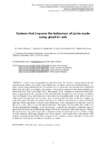Mostrar o rexistro simple do ítem
Systems that improve the behaviour of joints made using glued-in rods
| dc.contributor.author | Otero-Chans, Dolores | |
| dc.contributor.author | Estévez-Cimadevila, Javier | |
| dc.contributor.author | Martín-Gutiérrez, Emilio | |
| dc.contributor.author | Suárez-Riestra, Félix | |
| dc.date.accessioned | 2020-03-24T09:43:14Z | |
| dc.date.issued | 2019 | |
| dc.identifier.citation | Otero-Chans, D., J. Estévez-Cimadevila, E. Martín-Gutiérrez, and F. Suárez-Riestra. “Systems That Improve the Behaviour of Joints Made Using Glued-in Rods.” European Journal of Wood and Wood Products 77, no. 6 (September 19, 2019): 1079–1093. doi:10.1007/s00107-019-01461-4. | es_ES |
| dc.identifier.issn | 0018-3768 | |
| dc.identifier.uri | http://hdl.handle.net/2183/25223 | |
| dc.description.abstract | Joints made using glued-in rods have been the subject of many numerical and experimental studies. The joints most widely used are those known as cylindrical joints, i.e., joints made using cylindrical rods of constant cross-section that are inserted into cylindrical holes that also have a constant cross-section. Although no agreement has been reached at a European level that would allow their dimensions to be included in structural standards, there is agreement in the literature on the fact that joint strength does not increase in a linear way with length. It has also been found that there is a maximum joint length above which its withdrawal strength does not increase. After reviewing the literature on the use of glued-in rods, this paper classifies the papers that describe different alternatives to cylindrical holes that have been suggested to improve joint behaviour. These alternatives modify the shape of the rods or the holes, or use additional elements. The paper also describes the results of a broad experimental campaign, which performed a comparative analysis of different types of glued-in rods based on modifying the shape of the hole to increase joint load capacity without the need to use long anchorages. Three different forms of improvement were studied, using several different anchorage lengths and wood species. The results show alternatives that improve strength by up to 60% when compared with traditional joints and which can be used in different wood species at different slenderness values. | es_ES |
| dc.language.iso | eng | es_ES |
| dc.publisher | Springer | es_ES |
| dc.relation.uri | http://dx.doi.org/10.1007/s00107-019-01461-4 | es_ES |
| dc.rights | [Abstract] This is a post-peer-review, pre-copyedit version of an article published in European Journal of Wood and Wood Products. The final authenticated version is available online at: http://dx.doi.org/10.1007/s00107-019-01461-4 | es_ES |
| dc.subject | Glued-in rods | es_ES |
| dc.subject | Timber structures | es_ES |
| dc.subject | Joints | es_ES |
| dc.title | Systems that improve the behaviour of joints made using glued-in rods | es_ES |
| dc.type | info:eu-repo/semantics/article | es_ES |
| dc.rights.access | info:eu-repo/semantics/embargoedAccess | es_ES |
| dc.date.embargoEndDate | 2020-09-01 | es_ES |
| dc.date.embargoLift | 2020-09-01 | |
| UDC.journalTitle | European Journal of Wood and Wood Products | es_ES |
| UDC.volume | 77 | es_ES |
| UDC.issue | 6 | es_ES |
| UDC.startPage | 1079 | es_ES |
| UDC.endPage | 1093 | es_ES |
Ficheiros no ítem
Este ítem aparece na(s) seguinte(s) colección(s)
-
GI-GEA - Artigos [62]






